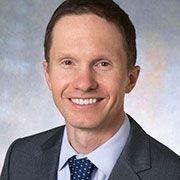Interview
Partnering with Community
Nathaniel Scott, MD, MHA, chief of clinical operations and quality, Hennepin Healthcare
We hear more and more about community-based care. How do you define this term?
The term community-based care can refer to a number of things. At Hennepin Healthcare, a focus on community is central to our mission as an organization. Our mission statement reads, “We partner with our community, our patients and their families to ensure access to outstanding care for everyone, while improving health and wellness through teaching, patient and community education and research.”
What is Hennepin Healthcare doing to provide community based care?
A couple of examples of how Hennepin Healthcare is working to directly meet the needs of our community include services such as our Pediatric Mobile Health Clinic, which brings well-child care, vaccination and other services to families for which coming to a clinic presents a challenge, as well as the Next Step program, in which youth and young adult victims of trauma are connected with resources and support.
HCMC is a teaching hospital. Please tell us about what this means, the value it brings and the challenges of providing these services.
Being a teaching hospital brings great value to our patients, the U of M Academic Health System, the learners, and hospitals and clinics across the state where our residents go to put their skills to work. Our patients benefit from being cared for by faculty physicians, who as teachers and researchers are advanced in their expertise working in partnership with exceptional residents and fellows. The university benefits by being able to offer residencies in a range of specialties at its largest off campus teaching partner located close to campus, and hospitals and clinics across Minnesota benefit by having well-trained clinicians who want to grow their careers in the state. While there is no single answer to the health care workforce shortage, having a major teaching hospital attracting and exposing the best and the brightest to the opportunities to live and work in our state is one of the solutions.
The challenges of being a teaching hospital include the complexity and cost of the infrastructure and operational implications when there isn’t sufficient reimbursement. The teaching environment introduces complexity to the care giving setting. The benefits outweigh the costs, but we continue to advocate for reimbursement models that recognize the added expense.
The way health care is financed is far from ideal.
Hennepin Healthcare has proposed extensive renovation and new construction of its downtown facilities. What can you share about these plans?
Our state-of-the-art outpatient clinic building opened in 2018 on our downtown campus, but our inpatient units are spread across several buildings that are 45-80 years old and need expensive, and at times, urgent repairs. When hospital capacity is already tight, taking a building, a floor or one or two rooms out of service for repairs can restrict our ability to meet the needs of our community and that ripples across our entire system in the state if we are unable to take referrals from other hospitals.
We have been engaging our patients, neighbors, team members and other leaders in conversation to create a vision for how our health care system will meet their needs and advance equity and justice. New hospital facility planning is complex and takes many years. Today we are identifying the right services, understanding market opportunities, and developing a roadmap for creating a compact, state-of-the-art, secure and sustainable health care campus in partnership with Hennepin County. We also are investing in improving how we integrate technology, data and analytics into how we serve our patients, which supports improving the overall experience for patients today and in our new facilities.
What are some of the benefits the new campus will bring?
At the very beginning of this work we identified principles that drive our work, and these lay out the benefits, including providing care in a setting that advances our ability to achieve equitable, high quality, patient and community-centered health care. To do that, we will create space that reflects the values, cultures and needs of the patients, families and communities we serve; offers an environment that attracts and nurtures exceptional team members and empowers them to deliver compassionate care; and supports the efficient provision of care to support the financial sustainability needed to meet our mission.
Hennepin Healthcare serves a much higher percentage of patients whose health care is covered by public programs than other health systems. Please discuss this and the unintended consequences that changes in existing reimbursement methods could cause.
Because of the high number of our patients on Medicaid, changes in how Medicaid is financed have a disproportionate impact on us. Nearly 50% of our patients are on Medicaid, and 78% are on public programs, far higher than any other health system. Because of our unique role, we are the only health system in the state that receives funding through a mechanism called directed payments, which leverages federal dollars to enhance Medicaid payment rates for patients that receive their services through Managed Care Organizations (MCOs). Today, MCOs provide payment for services at higher rates that are closer to the true cost of providing care. Any shift in patients away from MCOs would add further financial stress.
A legislative proposal that would have allowed patients to opt out of managed care would have resulted in a loss of millions of dollars. Our health system does not have a surplus of cash or other investments to offset these losses. Losses would directly impact the community we serve through workforce and service reductions, put our training program at risk, and potentially halt planning for updated facilities. As a safety-net provider with roots in the community going back to 1887, we annually provide approximately $115 million in uncompensated care and write off $60 million of care for underinsured patients. We do this while providing outstanding clinical care, educational programs that reach more than half of the providers working in the state today, and research to benefit our community. We would be at risk if this funding mechanism that is meant to alleviate financial strain on safety-net providers like us were altered without an adequate replacement funding source.
What can you tell us about the Minnesota Health Plan study?
In 2023, the Minnesota legislature approved a two-year study to understand what changes the state could make to the Medicaid program that would shift people away from Managed Care and understand the resulting tradeoffs. We support this analysis and are eager to partner with the state and other stakeholders to develop ideas for how our state Medicaid system can be improved upon and achieve the goals to improve patient choice, increase health equity and improve quality outcomes while enhancing financial stability for safety-net providers. The way health care is financed is far from ideal, a multi-faceted and complicated construction built over decades, so changes to the system must be carefully considered to avoid unintended consequences.
Delays in discharges cost Minnesota hospitals nearly half a billion dollars last year. What can you tell us about this complex problem?
Yes, that analysis from the Minnesota Hospital Association replicates a 2023 Minnesota Department of Human Services (DHS) voluntary survey of the state’s hospitals and health systems and found that there were nearly 195,000 avoidable patient days and unpaid care in 2023, and this cost hospitals and health systems an estimated $487 million in unpaid care. The human cost is when critical care is denied to a patient who needs it. If we are not able to discharge a patient when he or she is ready to move into a community setting, that is one bed fewer available for a patient in another hospital in Minnesota who requires our specialty care. In 2023, we turned away an average of 18 requests to transfer someone to our hospital each month. While this adds further financial pressure, more important it is a person who is unable to get the critical care needed, so lives are at stake.
Almost 70% of Minnesota hospitals experienced negative operating margins through the first half of 2023. What changes must be made to the health care financing system to address this?
We encourage the federal government to focus on protecting and expanding meaningful health insurance coverage and access to life-saving prescriptions and to invest in mental health, maternal health and child adolescent health. So much of the cost of health care today is because of a lack of access to preventive and supportive care and services early in life, which drives overwhelming needs for care and treatment. Specific to Hennepin Healthcare and safety-net providers, we advocate for greater alignment of federal reimbursement with the costs of care and hope to see payment methodologies in Medicaid and Medicare that recognize the challenges of caring for a disproportionate share of medically and socially complex patients.
Nathaniel Scott, MD, MHA, is the chief executive of clinical operations and quality, Hennepin Healthcare.
MORE STORIES IN THIS ISSUE
cover story one
Freedom Echoing: A legislative fix for health care?
By Kip Sullivan, JD
cover story two
Fall-Prevention Research: Improving health and cost savings
















